 Bryophytes are a group of small, simple, green land dwelling plants of which a few are aquatic comprising of Hornworts (Anthocerotopsida), Liverworts (Hepaticopsida), and Mosses (Bryopsida).
Bryophytes are a group of small, simple, green land dwelling plants of which a few are aquatic comprising of Hornworts (Anthocerotopsida), Liverworts (Hepaticopsida), and Mosses (Bryopsida).These are the largest group of land plants, which number about 25,000 different species found throughout the world. Most are found in areas which are humid and damp with a cold to moderately warm climate. They can withstand being frozen in snow without damage.

As Bryophytes are simple plants, most have no internal means for transporting water or nutrients. They are often said to have leaves but these are not equivalent to the leaves of vascular plants. Bryophytes are mostly one cell thick, although sometimes the midrib and stalk are several cells thick but do not contain any water conducting tissue. They don't have any roots but do have filamentous rhizoids, which are sometimes multicellular which do little more than anchor them down.

These plants do not produce flowers, and therefore never produce seeds. Plants that don't flower are called cryptogam and reproduce by spore production, with other cryptogams being fungi, slime moulds and ferns. The process by which they produce spores is termed alternation of generations.
 Alternation of generations is a life cycle involving two phases. The first is the gametophytic phase. This is where the gametes which are produced contain half the number of
Alternation of generations is a life cycle involving two phases. The first is the gametophytic phase. This is where the gametes which are produced contain half the number of